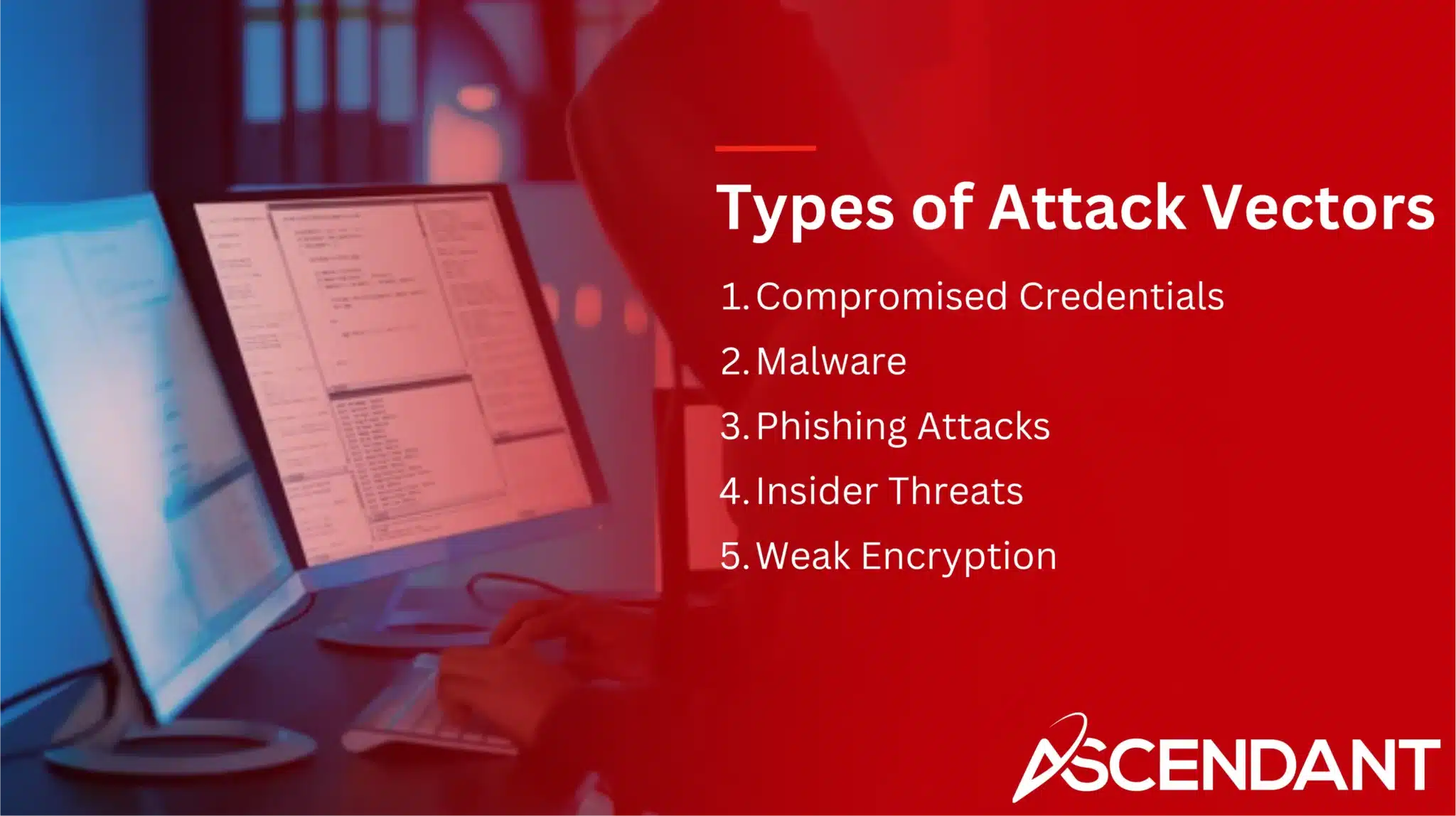Attack vectors are the methods and pathways cybercriminals use to infiltrate systems and steal data. Knowing what they are and how they work is essential for safeguarding your security. This article explains the main types of attack vectors, their implications, and how you can defend against them.
In This Article:
- Understanding Attack Vectors
- Types of Attack Vectors
- Active vs. Passive Attack Vectors
- How Attack Vectors Are Exploited
- Protecting Against Attack Vectors
- The Role of Third-Party Vendors
- Monitoring and Incident Response
- Leveraging Advanced Security Solutions
Key Takeaways
- Attack vectors are pathways that cyber attackers use to exploit vulnerabilities and gain unauthorized access to systems and data.
- Common attack vectors include compromised credentials, malware, phishing attacks, and insider threats, each requiring tailored defense mechanisms.
- Implementing multi-layered defense strategies, consisting of employee training, regular software updates, and advanced security solutions, is essential for protecting against evolving threats.
Understanding Attack Vectors
Cyber attackers utilize attack vectors to infiltrate systems, networks, and databases in an unauthorized manner. These are akin to concealed passageways and obscure entryways that enable trespassers to evade established security protocols. Identifying these threat vectors is pivotal for any comprehensive cybersecurity strategy.
To guard against targeted intrusions, it’s critical for organizations to identify the various attack vectors. Through understanding how attackers exploit system vulnerabilities, businesses can thwart attempts at network penetration and safeguard sensitive information from compromise. Attack vectors span a wide spectrum including software flaws, configuration errors within systems, as well as schemes involving social engineering. They continue to evolve constantly.
Gaining entry via such attack vectors may lead cybercriminals towards a host of nefarious deeds like theft of data, breach of system integrity or disruption of services. By grasping knowledge about these potential pathways into their infrastructure, organizations can custom-fit their defensive measures—thereby diminishing the overall attack surface—and better manage the risks associated with cyber threats.
Types of Attack Vectors
There are a variety of attack vectors that exploit various vulnerabilities across an organization’s attack surface and surfaces. These can include everything from malware and viruses to phishing attacks and social engineering tactics, which are among the most common methods employed by cybercriminals to target system vulnerabilities.
Understanding these different types is essential for creating robust defense strategies to protect against such threats.
Compromised Credentials
Credentials that have been compromised frequently originate from incidents like data breaches or phishing attacks, which in turn facilitate illicit entry into confidential systems. The stolen user credentials, encompassing both usernames and passwords, enable assailants to masquerade as authentic users. This subterfuge can easily circumvent standard security measures and makes identifying nefarious activities more challenging.
To reduce the dangers associated with compromised credentials, it is advisable to utilize certain tools such as password managers, two-factor authentication (2FA), and biometric verification methods. Employing Multi-Factor Authentication (MFA) is notably effective. It introduces an additional protective barrier that substantially impedes attackers’ ability to misuse stolen credentials.
Malware
Malicious software, known as malware, is crafted to damage or take advantage of computer systems. Malware comes in various forms such as viruses, ransomware, trojans, spyware and worms. To illustrate, Trojan horses mimic trustworthy software and ransomware locks data asking for a ransom to unlock it.
Phishing attacks or infiltrated networks are common methods that cybercriminals use to disseminate malware with the intention of stealing information or interrupting services. An effective defense against malware involves using antivirus programs, implementing firewalls and keeping systems updated regularly.
Phishing Attacks
Attackers engage in phishing attacks by crafting deceptive messages designed to fool people into divulging sensitive data. These schemes may unfold via emails, texts, or instant messages and typically strive to pilfer login details or implant malicious software.
To safeguard against these types of attacks, it’s recommended to employ spam filters, implement multi-factor authentication (MFA), and regularly educate staff on how to identify possible phishing endeavors. Inculcating a sense of caution among employees about treating each email as potentially harmful is instrumental in mitigating the threat posed by such attacks.
Insider Threats
Threats from within an organization can arise when employees who are dissatisfied or have malicious intentions abuse their network access to undermine sensitive data. Such individuals may take advantage of their legitimate rights to access information for the purposes of theft or operational sabotage, which makes it difficult to identify such breaches.
To counteract insider threats, one must vigilantly track network activity for any signs of irregularities and instances where files are accessed without authorization. Implementing robust security measures and adhering strictly to the least privilege doctrine are crucial in reducing vulnerabilities posed by malicious insiders.
Weak Encryption
Inadequate encryption can render sensitive information susceptible to intercept and unauthorized access in the event of data breaches. It is crucial to employ proper encryption techniques to hinder cyber attackers from accessing, pilfering, or altering sensitive data.
If sensitive information isn’t encrypted sufficiently, it becomes readily accessible to those without authorization, potentially resulting in substantial security violations. Ensuring all sensitive data is adequately encrypted is essential for protection against cyber threats.
Active vs. Passive Attack Vectors
Attack vectors are divided into two main types: active and passive. Active attack vectors aim to directly infiltrate or destabilize systems, whereas passive attack vectors center on the collection of information without inflicting direct damage at the time of gathering.
It is essential to differentiate between active and passive types when formulating extensive security strategies.
Active Attack Vectors
Direct attempts to exploit vulnerabilities are among the active attack vectors, with the intent being to gain unauthorized access. Such attacks encompass various forms like ransomware, credential theft, and brute force assaults designed either to interrupt operational functionality or to pilfer sensitive data. In this framework of discussion, active attacks are also pertinent.
For example, a DDoS (Distributed Denial-of-Service) attack floods a network with an excessive amount of traffic until it collapses. This results in legitimate users losing service availability. While these types of disturbances tend to be more traceable due to their obvious nature, they can inflict considerable harm if not swiftly mitigated.
Passive Attack Vectors
Attack vectors that are passive in nature concentrate on monitoring and collecting data without interfering with the functioning of systems. Examples of such attacks include social engineering tactics and secret listening to communications, which leverage human psychological weaknesses and clandestine methods to acquire sensitive data.
The consequences of these passive forms of attack underscore the importance of being vigilant and implementing safeguards against hidden efforts aimed at information acquisition.
How Attack Vectors Are Exploited
Cybercriminals employ a range of strategies to exploit attack vectors, including passive methods such as social engineering and active tactics like deploying malware or initiating DDoS attacks. Utilizing these techniques enables them to gain unauthorized access to systems and steal sensitive data.
When attackers successfully exploit attack vectors, it can result in significant disruption for an organization by causing data breaches and undermining the integrity of the compromised data. Understanding how these vectors are manipulated is crucial for crafting robust security measures.
Protecting Against Attack Vectors
To safeguard against various attack vectors, an organization must deploy a defense strategy that encompasses several layers. This includes educating employees, consistently updating software, and establishing stringent security protocols. By putting into place extensive security measures, the cybersecurity stance of an entity is substantially improved.
Employee Security Awareness Training
Consistent education helps staff stay alert to new dangers and the measures they can take in advance to counteract these threats. It is critical for users to recognize the tactics that could deceive them into disclosing login information or circumventing protective protocols.
Implementing training methodologies should concentrate on underlining the necessity of robust password practices, adopting password management software, installing antivirus solutions, and making use of VPNs (Virtual Private Networks) as a means of securing their online sessions.
Regular Software Updates and Patching
Cybercriminals often exploit unpatched vulnerabilities as a means to gain unauthorized access and exert control over systems. By instituting automated update mechanisms, the number of susceptibilities can be greatly diminished across various platforms. Establishing an all-encompassing system for software patch management prevents possible exploitation and strengthens the protection of data.
Consistent updates applied to software and operating systems serve to seal off security flaws, thereby improving the general security posture of those systems.
Implementing Multi Factor Authentication
Employing multi-factor authentication (MFA), which mandates various verification steps for access, bolsters security and mitigates the dangers associated with compromised credentials within organizations.
By necessitating several forms of validation, these measures heighten the complexity of any unauthorized entry efforts. Consequently, this robust defense makes it considerably more challenging for cyber attackers to misuse purloined login details.
The Role of Third-Party Vendors
Third-party suppliers may create potential weaknesses within an organization’s security structure, rendering it prone to cyber threats. These vulnerabilities can be leveraged by attackers to gain access to confidential information, resulting in monetary damage and reputational harm.
In order to manage the risks associated with third-party relationships effectively, organizations must actively seek out potential hazards, maintain continuous oversight, and adhere strictly to data security laws. Reducing exposure from these external entities can be achieved through network compartmentalization and allocation of resources towards advanced threat detection technologies.
Monitoring and Incident Response
Continuous monitoring encompasses the ongoing, automated observation of IT landscapes to swiftly identify potential cybersecurity dangers and weaknesses. By integrating data from multiple sources, these robust systems deliver thorough intelligence that promotes prompt action when incidents arise.
Incorporating automated mechanisms for responding to threats drastically cuts down on the duration required to manage security breaches, enhancing the rapidity with which threats can be contained. Real-time threat detection is augmented by behavioral analytics that spot nascent risks through scrutiny of departures from normal user behavior patterns.
Leveraging Advanced Security Solutions
Essential for bolstering cybersecurity and lessening potential threats, advanced security measures play a pivotal role in strengthening an organization’s defenses. Tools such as Email Protection, Cloud Access Security Broker (CASB), and Insider Threat Management are instrumental in safeguarding against various cyber dangers.
Utilizing AI along with behavior analytics within the realm of cybersecurity allows for the real-time observation of both user actions and device operations, facilitating prompt identification of any unusual activities. Integrating threat intelligence into these surveillance systems aids in distinguishing actual risks from harmless alerts, thus concentrating efforts on true threats instead of erroneous alarms.
 Summary
Summary
In conclusion, understanding and defending against attack vectors are essential for maintaining robust cybersecurity. By recognizing common threats and implementing comprehensive security measures, organizations can significantly reduce their risk of cyber-attacks and protect sensitive data.
Frequently Asked Questions
What are attack vectors?
Attack vectors are the methods or pathways that attackers use to gain unauthorized access to systems and exploit vulnerabilities. Understanding these vectors is crucial for strengthening security measures against potential threats.
What is the difference between active and passive attack vectors?
It is essential to distinguish between active and passive attack vectors for the development of robust security protocols. Active attack vectors exploit vulnerabilities aggressively to compromise systems, while passive attack vectors aim to discreetly gather information without inflicting direct harm at the moment of the attack.
How can organizations protect against phishing attacks?
To effectively protect against phishing attacks, organizations should implement spam filters, utilize multi-factor authentication, and provide regular training for employees to identify phishing attempts.
This approach significantly enhances overall security awareness and reduces vulnerability.
Why is regular software updating and patching important?
Ensuring that software is routinely updated and patched is crucial for addressing security flaws, thereby minimizing vulnerabilities and substantially improving the security of your system.
By giving priority to these updates, you safeguard against possible dangers while maintaining the dependability of your software.
What role do third-party vendors play in cybersecurity?
Active risk management and strict adherence to data protection regulations are essential due to the potential for third-party vendors to introduce vulnerabilities that can affect an organization’s cybersecurity.
Evaluating and overseeing these vendors is vital in order to protect your security infrastructure.


